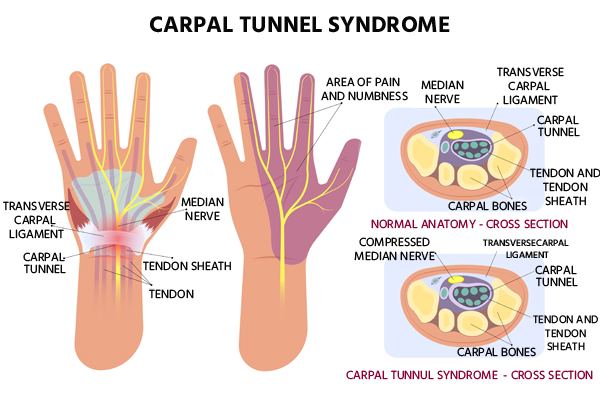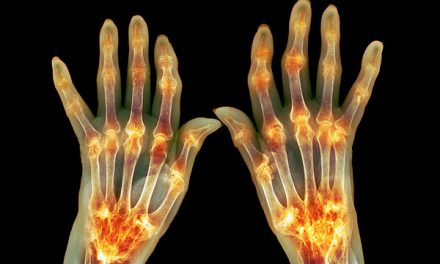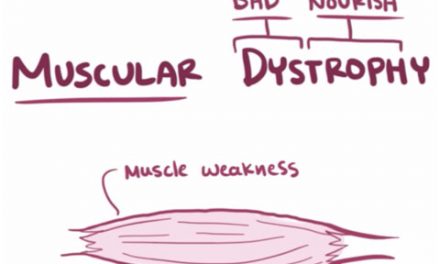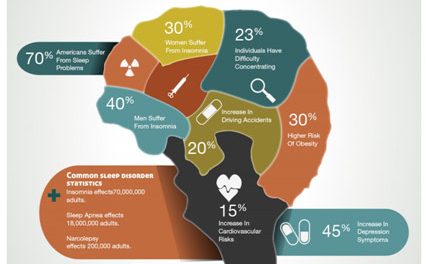Carpal Tunnel Syndrome (CTS), a disorder that impacts more than 8 million people in a year, is becoming more and more common among computer programmers. My first encounter with Carpal tunnel occurred when my mother had been feeling pins and needles in her hand for hours on end. CTS is a disorder in which the carpal tunnel, a region which provides a passageway to our radial, median, and ulnar nerves and builds up the wrist, comes under great duress causing the suppression of nerves and causing pins and needles in our hand. Carpal Tunnel Syndrome happens to impact women more than men due to hormonal changes which cause swelling in the wrist putting pressure on the nerves.
But to understand the cause of this we have to first understand the anatomy and physiology of the hand. The human hand consists of twenty-seven bones and eight bones in the wrist called carpals. These carpals are connected by the radius and ulna. Further on, these carpals transform into five metacarpals which form the palm of the hand. Each metacarpal forms a connection to the five fingers. Small bone shafts in the hand that connect smaller bones are called phalanges. The connection between these phalanges and metacarpal joints forms the main knuckle joints called the Metacarpophalangeal Joints (MCJs). These joints are hinge joints which connect three different types of phalanges in a finger: the proximal, middle, and distal phalanges respectively.
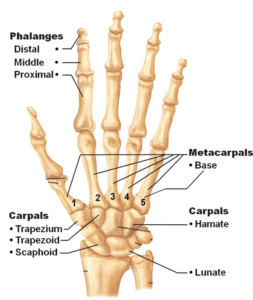
Anatomy of the Human Hand
The human hand consists of three nerves: the radial, the ulnar and the median. These nerves go all the way from our shoulders to the tip of our fingers. But the nerve that I want to focus on is the median nerve. the median nerve predominantly controls our hand. the nerve branches out controlling the thumb including the thenar muscles, index finger, long finger and half of the ring finger.
The carpal tunnel is a narrow passageway made up of bones and ligaments through which the Median nerve travels. When some type of swelling or thickening in the lining of the tendons occurs, the pressure is exerted on the Median nerve causing numbness, weakness and sometimes pain in the hand/wrist. If no treatment is provided, in severe cases the patient may lose their sense of touch entirely.
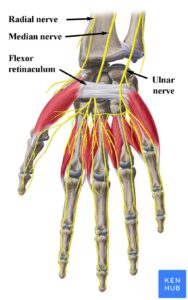
Nerves of the wrist and hand
Symptoms:
- In the mornings, tingling, pain and burning in the thumb, index finger, long finger, and ring finger
- Shock-like sensations that travel unto the forearm
- Weakness and clumsiness in the hand
- Dropping things due to weakness, numbness or a loss of proprioception (awareness of where your hand is in space)
Although this may seem daunting, treatment does exist to relieve the patient of this pain. the treatment ranges from daily exercise to surgical procedures in dire cases.
When my mother was consulting a specialist regarding CTS, he suggested instead of doing surgery she should start wearing a splint, to make sure that her hand does not get in the wrong position and do some exercise to keep her hand active. And if it still does not work out, then they should go towards surgery. My mother tried this for a month and saw improvement in the condition of her hand. Some surgeries are invasive treatments for the problem unless the severe conditions call for severe measures. The doctor may also give the patient non-steroidal inflammatory drugs to relieve pain from inflammation in the tendon lining.
There are two types of surgical treatments, Open Carpal Tunnel Release and Endoscopic Carpal Tunnel Release.
Open Carpal Tunnel Release:
- In this operation, the surgeon will make a small incision in the palm of the patient’s hand. Through the said incision, the doctor takes a camera to view the carpal tunnel. The roof of the carpal tunnel is divided, reducing the pressure on the median nerve. The roof will eventually grow back, but there will be more space for the median nerve to travel through.
Endoscopic Carpal Tunnel Release:
- While, the operation is very similar to open carpal tunnel release, in this case, the surgeon will use the small incision to view your hand through a camera and then divides the transverse carpal ligament. This reduces the pressure on the carpal tunnel.
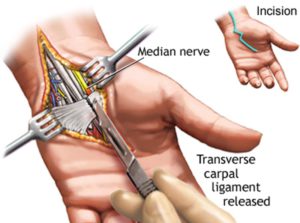
Open Carpal Tunnel Release Surgery
It was found that people who have undergone Endoscopic Carpal Tunnel Release have returned to their respective occupations eight days faster than patients who have undergone Open Carpal Tunnel Release. In spite of this disadvantage, Open Carpal Tunnel Release is more efficient and successful than Endoscopic Carpal Tunnel Release. Considering these facts, the patient should consult their doctor regarding what kind of surgery should they should undergo.
In whichever way Capral Tunnel Syndrome may have found its way to you, may it be from improper typing practices to playing a rigorous sport requiring extensive use of your wrist, there are many solutions to remove this strain. CTS is currently on the rise due to harsh working conditions in the video game industry, where workers have to type for hours on end increasing the number of Carpal Tunnel Syndrome cases. Many are unaware of the proper typing practices and how to position their arms and wrists while typing. We live in a society where we need to type to make our way through. So, to make sure that we can still survive in our world, people need to be made more aware of how to prevent Carpal Tunnel Syndrome.
References
Anterior View of the Left Hand [Image]. (n.d.). https://www.google.com/url?sa=i&url=https%3A%2F%2Fslideplayer.com%2Fslide%2F13307551%2F&psig=AOvVaw1g1Lpgv-lVHr2kcVzIW7-0&ust=1672975636682000&source=images&cd=vfe&ved=0CA8QjRxqFwoTCMD8lYa-r_wCFQAAAAAdAAAAABAE
Carpal Tunnel Surgical Procedure [Image]. (2021, June 13). Medicine Plus. https://www.google.com/url?sa=i&url=https%3A%2F%2Fmedlineplus.gov%2Fency%2Fimagepages%2F19250.htm&psig=AOvVaw3nMvQI2Kl-K-UGxAmO-x5i&ust=1672886405523000&source=images&cd=vfe&ved=0CA8QjRxqFwoTCLi6tNHxrPwCFQAAAAAdAAAAABAI
Carpal Tunnel Syndrome [Image]. (n.d.). https://www.google.com/url?sa=i&url=https%3A%2F%2Fwww.medicoverhospitals.in%2Fdiseases%2Fcarpa-tunnel-syndrome%2F&psig=AOvVaw1Ij_dmMYQmOPqTe_4kEJra&ust=1673045569651000&source=images&cd=vfe&ved=0CA8QjRxqFwoTCPCH5MjCsfwCFQAAAAAdAAAAABAJ
Carpal Tunnel Syndrome. (2022, March). OrthoInfo. Retrieved July 3, 2022, from https://orthoinfo.aaos.org/en/diseases–conditions/carpal-tunnel-syndrome/#:~:text=Carpal%20tunnel%20syndrome%20is%20a,syndrome%20gets%20worse%20over%20time.
Carpal Tunnel Syndrome: A Review of Literature. (2020, March 19). Cureus. Retrieved July 9, 2022, from https://www.cureus.com/articles/29112-carpal-tunnel-syndrome-a-review-of-literature
Carpal Tunnel Syndrome Fact Sheet [Fact sheet]. (2020, March). National Institute of Neurological Disorders and Stroke. Retrieved January 3, 2023, from https://www.ninds.nih.gov/carpal-tunnel-syndrome-fact-sheet
Nerves of the wrist and hand [Image]. (2021, November). Research Gate. https://www.google.com/url?sa=i&url=https%3A%2F%2Fwww.researchgate.net%2Ffigure%2FNerves-of-the-wrist-and-hand-Note-the-position-of-the-median-nerve-under-the-flexor_fig1_356122286&psig=AOvVaw3jZLt2CGUuGGwwVmKCq-YN&ust=1672975065266000&source=images&cd=vfe&ved=0CA8QjRxqFwoTCLCu2vW7r_wCFQAAAAAdAAAAABAR
Parisien, R. L., & Kasparyan, N. G. (2016, May 1). Face Off: Open Versus Endoscopic Carpal Tunnel Release. AAOS Now. Retrieved December 9, 2022, from https://www.aaos.org/aaosnow/2016/may/cover/cover02/

